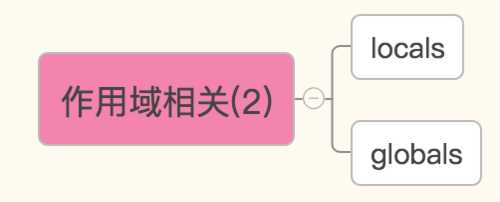python 内置函数大讲堂
python全栈开发,内置函数
1. 内置函数
python的内置函数截止到python版本3.6.2,现在python一共为我们提供了68个内置函数。它们就是python提供给你直接可以拿来使用的所有函数。那今天我们就一起来认识一下python的内置函数。
上面就是内置函数的表,68个函数都在这儿了。这个表的顺序是按照首字母的排列顺序来的,你会发现都混乱的堆在一起。比如,oct和bin和hex都是做进制换算的,但是却被写在了三个地方。。。这样非常不利于大家归纳和学习。那我把这些函数分成了6大类。你看下面这张图:
上图中,标红的四大块有56个方法。今天先学习这些。
1-1. 作用域相关的函数
enter description here
基于字典的形式获取局部变量和全局变量
globals()——获取全局变量的字典
locals()——获取执行本方法所在命名空间内的局部变量的字典
Output:
{'name': 'main', 'doc': None, 'package': None, 'loader': <_frozen_importlib_external.SourceFileLoader object at 0x00F6EE30>, 'spec': None, 'annotations': {}, 'builtins': <module 'builtins' (built-in)>, 'file': 'D:/Study/BaiduNetdiskDownload/day15课堂笔记/Func.py', 'cached': None}
{'name': 'main', 'doc': None, 'package': None, 'loader': <_frozen_importlib_external.SourceFileLoader object at 0x00F6EE30>, 'spec': None, 'annotations': {}, 'builtins': <module 'builtins' (built-in)>, 'file': 'D:/Study/BaiduNetdiskDownload/day15课堂笔记/Func.py', 'cached': None}
1-2. 其他
enter description here
1-2-1. eval、exec、compile
eval() 将字符串类型的代码执行并返回结果
print(eval('1+2+3+4'))
Output :
10exec()将自字符串类型的代码执行,返回位None.
此函数支持Python代码的动态执行。object必须是字符串或代码对象。如果它是一个字符串,则将该字符串解析为一组Python语句,然后执行该语句(除非发生语法错误),如果是代码对象,则只执行它。在所有情况下,执行的代码应该作为文件输入有效(请参见“参考手册”中的“文件输入”部分)。请注意,
即使在传递给函数的代码的上下文中,也不能在函数定义之外使用return和yield语句 exec()。返回值是None。
print(exec("1+2+3+4"))
exec("print('hello,world')")
Output:Nonehello,world再看一段代码
code = '''
import os
print(os.path.abspath('.'))
'''code = '''
print(123)
a = 20
print(a)
'''a = 10exec(code,{'print':print},)
print(a)#Ouput:1232010注意:如果把exec(code,{'print':print},)改成exec(code),则输出:123 20 20
compile 将字符串类型的代码编译。代码对象能够通过exec语句来执行或者eval()进行求值。
参数说明:
参数source:字符串或者AST(Abstract Syntax Trees)对象。即需要动态执行的代码段。
参数 filename:代码文件名称,如果不是从文件读取代码则传递一些可辨认的值。当传入了source参数时,filename参数传入空字符即可。
参数model:指定编译代码的种类,可以指定为 ‘exec’,’eval’,’single’。当source中包含流程语句时,model应指定为‘exec’;当source中只包含一个简单的求值表达式,model应指定为‘eval’;当source中包含了交互式命令语句,model应指定为'single'。
>>> #流程语句使用exec>>> code1 = 'for i in range(0,10): print (i)'>>> compile1 = compile(code1,'','exec')>>> exec (compile1)13579>>> #简单求值表达式用eval>>> code2 = '1 + 2 + 3 + 4'>>> compile2 = compile(code2,'','eval')>>> eval(compile2)>>> #交互语句用single>>> code3 = 'name = input("please input your name:")'>>> compile3 = compile(code3,'','single')>>> name #执行前name变量不存在Traceback (most recent call last):
File "<pyshell#29>", line 1, in <module>
name
NameError: name 'name' is not defined>>> exec(compile3) #执行时显示交互命令,提示输入please input your name:'pythoner'>>> name #执行后name变量有值"'pythoner'"1-2-2. 输入输出相关的函数
print() input
s = input("请输入内容 : ") #输入的内容赋值给s变量print(s) #输入什么打印什么。数据类型是strprint()输出
def print(self, *args, sep=' ', end='\n', file=None): # known special case of print
"""
print(value, ..., sep=' ', end='\n', file=sys.stdout, flush=False)
file: 默认是输出到屏幕,如果设置为文件句柄,输出到文件
f = open('tmp_file','w')
print(123,456,sep=',',file = f,flush=True)
sep: 打印多个值之间的分隔符,默认为空格
end: 每一次打印的结尾,默认为换行符
flush: 立即把内容输出到流文件,不作缓存
"""用print打印一个进度条
import timefor i in range(0,101,2): time.sleep(0.1) char_num = i//2 #打印多少个'*' per_str = '\r%s%% : %s\n' % (i, '*' * char_num) if i == 100 else '\r%s%% : %s'%(i,'*'*char_num) print(per_str,end='', flush=True)#小越越 : \r 可以把光标移动到行首但不换行#Output(动态的):100% : **************************************************
1-2-3. 数据类型相关
type(o) 返回变量o的数据类型
1-2-4. 内存相关
id(o) o是参数,返回一个变量的内存地址
hash(o) o是参数,返回一个可hash变量的哈希值,不可hash的变量被hash之后会报错。
t = (1,2,3) l = [1,2,3] print(id(t)) print(hash(t)) #可hashprint(hash(l)) #会报错
Output:
59483960
Traceback (most recent call last):
-378539185
File "D:/Study/BaiduNetdiskDownload/day15课堂笔记/Func.py", line 30, in
print(hash(l)) #会报错
TypeError: unhashable type: 'list'
hash函数会根据一个内部的算法对当前可hash变量进行处理,返回一个int数字。每一次执行程序,内容相同的变量hash值在这一次执行过程中不会发生改变。
1-2-5. 文件操作相关
open() 打开一个文件,返回一个文件操作符(文件句柄),操作文件的模式有r,w,a,r+,w+,a+
共6种,每一种方式都可以用二进制的形式操作(rb,wb,ab,rb+,wb+,ab+),可以用encoding指定编码,不在多说。
1-2-6. 模块操作相关
__import__导入一个模块
1-2-7. 帮助方法
在控制台执行help()进入帮助模式。可以随意输入变量或者变量的类型。输入q退出
或者直接执行help(o),o是参数,查看和变量o有关的操作。。。
1-2-8. 和调用相关
callable(o),o是参数,看这个变量是不是可调用。 如果o是一个函数名,就会返回True
def func():passprint(callable(func)) #参数是函数名,可调用,返回Trueprint(callable(123)) #参数是数字,不可调用,返回False
1-2-9. 查看参数所属类型的所有内置方法
print(dir(list)) #查看列表的内置方法print(dir(int)) #查看整数的内置方法#Output:['__add__', '__class__', '__contains__', '__delattr__', '__delitem__', '__dir__', '__doc__', '__eq__', '__format__', '__ge__', '__getattribute__', '__getitem__', '__gt__', '__hash__', '__iadd__', '__imul__', '__init__', '__init_subclass__', '__iter__', '__le__', '__len__', '__lt__', '__mul__', '__ne__', '__new__', '__reduce__', '__reduce_ex__', '__repr__', '__reversed__', '__rmul__', '__setattr__', '__setitem__', '__sizeof__', '__str__', '__subclasshook__', 'append', 'clear', 'copy', 'count', 'extend', 'index', 'insert', 'pop', 'remove', 'reverse', 'sort'] ['__abs__', '__add__', '__and__', '__bool__', '__ceil__', '__class__', '__delattr__', '__dir__', '__divmod__', '__doc__', '__eq__', '__float__', '__floor__', '__floordiv__', '__format__', '__ge__', '__getattribute__', '__getnewargs__', '__gt__', '__hash__', '__index__', '__init__', '__init_subclass__', '__int__', '__invert__', '__le__', '__lshift__', '__lt__', '__mod__', '__mul__', '__ne__', '__neg__', '__new__', '__or__', '__pos__', '__pow__', '__radd__', '__rand__', '__rdivmod__', '__reduce__', '__reduce_ex__', '__repr__', '__rfloordiv__', '__rlshift__', '__rmod__', '__rmul__', '__ror__', '__round__', '__rpow__', '__rrshift__', '__rshift__', '__rsub__', '__rtruediv__', '__rxor__', '__setattr__', '__sizeof__', '__str__', '__sub__', '__subclasshook__', '__truediv__', '__trunc__', '__xor__', 'bit_length', 'conjugate', 'denominator', 'from_bytes', 'imag', 'numerator', 'real', 'to_bytes']
1-3. 和数字相关
enter description here
数字——数据类型相关:bool,int,float,complex
数字——进制转换相关:bin,oct,hex
数字——数学运算:abs,divmod,min,max,sum,round,pow
print(bin(10)) #二进制 0b1010print(oct(10)) #八进制 0o12print(hex(10)) #十六进制 0xaprint(abs(-5)) print(abs(5)) print(divmod(7,2)) # div出发 mod取余 (3, 1)print(divmod(9,5)) # 除余 (1, 4)print(round(3.14159,3)) #3.142print(pow(2,3)) #pow幂运算 == 2**3print(pow(3,2)) print(pow(2,3,3)) #幂运算之后再取余 2print(pow(3,2,1)) # 0ret = sum([1,2,3,4,5,6]) print(ret) #21ret = sum([1,2,3,4,5,6,10],) print(ret) #31print(min([1,2,3,4])) print(min(1,2,3,4)) print(min(1,2,3,-4)) print(min(1,2,3,-4,key = abs)) #按绝对值取最小值 1print(max([1,2,3,4])) print(max(1,2,3,4)) print(max(1,2,3,-4)) print(max(1,2,3,-4,key = abs)) #按绝对值取最大值 -4
1-4. 和数据结构相关
enter description here
序列——列表和元组相关的:list和tuple
序列——字符串相关的:str,format,bytes,bytearry,memoryview,ord,chr,ascii,repr
# bytes 转换成bytes类型# 我拿到的是gbk编码的,我想转成utf-8编码print(bytes('你好',encoding='GBK')) # unicode转换成GBK的bytesprint(bytes('你好',encoding='utf-8')) # unicode转换成utf-8的bytes# 网络编程 只能传二进制# 照片和视频也是以二进制存储# html网页爬取到的也是编码b_array = bytearray('你好',encoding='utf-8')
print(b_array)
print(b_array[0])'\xe4\xbd\xa0\xe5\xa5\xbd'OutPut:b'\xc4\xe3\xba\xc3'b'\xe4\xbd\xa0\xe5\xa5\xbd'bytearray(b'\xe4\xbd\xa0\xe5\xa5\xbd')228序列:reversed,slice
reversed 保留原列表,返回一个反向的迭代器
l = [1,2,3,4,5] l.reverse() print(l) l = [1,2,3,4,5] l2 = reversed(l) print(l2) Output: [5, 4, 3, 2, 1] <list_reverseiterator object at 0x014DEEB0>
slice 切片,和[]效果一样
l = (1,2,23,213,5612,342,43) sli = slice(1,5,2) print(l[sli]) print(l[1:5:2])
1-5. 数据集合
字典和集合:dict,set,frozenset
数据集合:len,sorted,enumerate,all,any,zip,filter,map
1-5-1. filter
filter()函数接收一个函数 f 和一个list,这个函数 f 的作用是对每个元素进行判断,返回 True或
False,filter()根据判断结果自动过滤掉不符合条件的元素,返回由符合条件元素组成的新list。
例如,要从一个list [1, 4, 6, 7, 9, 12, 17]中删除偶数,保留奇数,首先,要编写一个判断奇数的函数:
def is_odd(x): return x % 2 == 1
然后,利用filter()过滤掉偶数:
>>>list(filter(is_odd, [1, 4, 6, 7, 9, 12, 17]))
Output:
[1, 7, 9, 17]
利用filter(),可以完成很多有用的功能,例如,删除 None 或者空字符串:
def is_not_empty(s): return s and len(s.strip()) > 0>>>list(filter(is_not_empty, ['test', None, '', 'str', ' ', 'END'])) >>> 结果: ['test', 'str', 'END']
注意: s.strip(rm) 删除 s 字符串中开头、结尾处的 rm 序列的字符。当rm为空时,默认删除空白符(包括'\n', '\r', '\t', ' '),如下:
>>> a = ' 123'>>> a.strip()'123'>>> a = '\t\t123\r\n'>>> a.strip()'123'
请利用filter()过滤出1~100中平方根是整数的数,即结果应该是:[1, 4, 9, 16, 25, 36, 49, 64, 81, 100]
方法:
import mathdef is_sqr(x): return math.sqrt(x) % 1 == 0print(list(filter(is_sqr, range(1, 101)))) 结果: [1, 4, 9, 16, 25, 36, 49, 64, 81, 100]
1-5-2. map
Python中的map函数应用于每一个可迭代的项,返回的是一个结果list。如果有其他的可迭代参数传进来,map函数则会把每一个参数都以相应的处理函数进行迭代处理。map()函数接收两个参数,一个是函数,一个是序列,map将传入的函数依次作用到序列的每个元素,并把结果作为新的list返回。
有一个list, L = [1,2,3,4],我们要将f(x)=x^2作用于这个list上,那么我们可以使用map函数处理。
>>> L = [1,2,3,4] >>> def pow2(x): ... return x*x ... >>> list(map(pow2,L)) [1, 4, 9, 16]
注意:
1 filter 执行了filter之后的结果集合 <= 执行之前的个数,filter只管筛选,不会改变原来的值
2 map 执行前后元素个数不变,值可能发生改变
1-5-3. Sorted
对List、Dict进行排序,Python提供了两个方法 对给定的List L进行排序,
方法1.用List的成员函数sort进行排序,在本地进行排序,不返回副本
方法2.用built-in函数sorted进行排序(从2.4开始),返回副本,原始输入不变
sorted(iterable, key=None, reverse=False)
Return a new list containing all items from the iterable in ascending order.
A custom key function can be supplied to customise the sort order, and the
reverse flag can be set to request the result in descending order.
参数说明:
iterable:是可迭代类型;
key:传入一个函数名,函数的参数是可迭代类型中的每一项,根据函数的返回值大小排序;
reverse:排序规则. reverse = True 降序 或者 reverse = False 升序,有默认值。
返回值:有序列表
列表按照其中每一个值的绝对值排序
l1 = [1,3,5,-2,-4,-6] l2 = sorted(l1,key=abs) print(l1) print(l2)
列表按照每一个元素的len排序
l = [[1,2],[3,4,5,6],(7,),'123'] print(sorted(l,key=len))
注意:和sort的区别
l = [1,-4,6,5,-10] l.sort(key = abs) # 在原列表的基础上进行排序print(l) print(sorted(l,key=abs,reverse=True)) # 生成了一个新列表 不改变原列表 占内存print(l) l = [' ',[1,2],'hello world'] new_l = sorted(l,key=len) print(new_l) 结果: [1, -4, 5, 6, -10] [-10, 6, 5, -4, 1] [1, -4, 5, 6, -10] [[1, 2], ' ', 'hello world']
共同学习,写下你的评论
评论加载中...
作者其他优质文章











